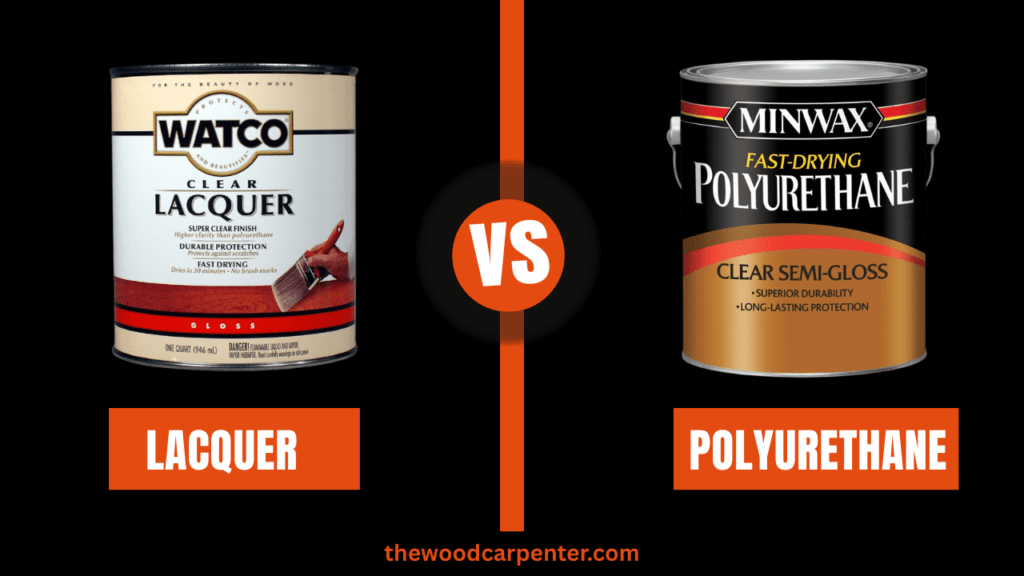
Finishing wood helps protect it and make it look nice. Two common finishes are lacquer and polyurethane. Each has its own strengths and is good for different kinds of wood projects like furniture, cabinets, floors, or decorations. Knowing the difference can help you choose the right one for your job.
What Is Lacquer ?
Lacquer is an old and popular wood finish known for its shiny look and fast drying. It’s usually made from a substance called nitrocellulose mixed with strong-smelling liquids (called solvents) that dry quickly.
Today, there are safer types of lacquer, like acrylic or water-based versions, that are better for the environment. Still, many professionals prefer solvent-based lacquer because it dries fast and looks very clear.
What’s in Lacquer and How It Works
Main Ingredient: Nitrocellulose or acrylic mixed with solvents like acetone or toluene.
How It Dries: The solvent evaporates (disappears into the air), leaving a hard and shiny surface.
Finish: It creates a thin, clear layer that slightly soaks into the wood and smooths the surface.
Special Feature: New coats of lacquer melt into the old ones, so you don’t need to sand between coats.
Why Use Lacquer ?
Dries Quickly: Touch-dry in 10–30 minutes. You can apply many coats in a short time.
Beautiful Shine: Gives wood a clear, glossy look that doesn’t turn yellow with age.
Smooth Finish: Best sprayed on for a nice, even coat with no brush marks.
Easy to Fix: Scratches or damage can be fixed by adding more lacquer — the new layer blends in with the old.
Great for Details: Thin and quick-drying, so it’s good for furniture with carvings or fine grain.
Lacquer’s Downsides
Not Very Tough: Softer than polyurethane and easier to scratch or damage with heat.
Can Be Damaged by Liquids: Things like alcohol or cleaning sprays can ruin the surface.
Strong Smell: Traditional lacquer has strong fumes and needs good airflow and safety gear.
Not for High Use Areas: It’s not the best choice for floors or places that get a lot of wear.
What Is Polyurethane ?
Polyurethane is a strong, man-made wood finish designed to handle tough use. It forms a hard, plastic-like layer on the surface of wood and is great for protecting it in busy or messy areas like floors, kitchens, and workspaces. Unlike lacquer, it hardens through a chemical reaction, not just drying.
What’s in Polyurethane and How It Works
Main Ingredient: A type of plastic resin made from oil-based or water-based chemicals.
How It Cures: It hardens by a chemical process that bonds tightly to the wood surface.
Finish Type: Forms a thick, clear (or tinted) layer that completely covers and protects the wood.
Flexibility: Some formulas stay slightly flexible, so the finish won’t crack if the wood moves or gets bumped.
Why Use Polyurethane ?
Very Durable: Resists scratches, heat, water, and everyday wear. Great for floors, countertops, and furniture.
Different Looks: You can choose matte, satin, semi-gloss, or glossy finishes depending on the style you want.
Water-Based vs Oil-Based:
Oil-Based: Harder and more durable. Gives a warm, golden tone over time, but smells more and takes longer to dry.
Water-Based: Dries faster, stays clear (no yellowing), and has less odor — better for indoor use with less ventilation.
Water Protection: Seals the wood well and helps stop swelling or damage in humid areas.
Oil-Based Stain vs Water-Based Stain: Which One Should You Choose?
Downsides of Polyurethane
Takes Longer to Dry: Each coat needs several hours to dry — more for oil-based versions — so projects take longer.
May Leave Brush Marks: Usually applied with a brush, so it can leave lines or bubbles if not done carefully.
Hard to Fix: If damaged, the finish can’t be touched up easily — you’ll often need to sand and refinish the whole area.
Fumes and Chemicals: Oil-based versions give off strong fumes and contain more VOCs, so you need good airflow and safety gear.
Key Differences Summary
| Aspect | Lacquer | Polyurethane |
| Base Material | Nitrocellulose or acrylic (solvent-based) | Synthetic polymer resin (oil-based or water-based) |
| Application Methods | Sprayed (most common), brush (less common) | Brushed, wiped, sprayed |
| Drying Time | 10–30 minutes (fast drying) | 2–6 hours (water-based); up to 24 hours (oil-based) |
| Film Thickness | Thin, penetrates wood grain | Thick, forms a plastic-like protective layer |
| Finish Look | High-gloss, clear, bright | Variety: matte to high-gloss; oil poly amber with age |
| Durability | Moderate—vulnerable to scratches and heat | High—scratch-resistant, chemical and moisture-proof |
| Repairability | Easy—blends with new coats without sanding | Difficult—requires sanding and refinishing |
| Odor and VOCs | Strong solvent odor; high VOCs in traditional types | Oil-based: strong odor; water-based: low odor and VOCs |
| Best Uses | Fine furniture, musical instruments, indoor decor | Floors, tabletops, kitchen cabinets, high-traffic surfaces |
| Shelf Life and Storage | Usually requires cool, sealed storage (flammable) | Generally more stable, but varies by product |
Practical Implications: Choosing Between Lacquer and Polyurethane
When to Use Lacquer
Choose lacquer if:
- You need your project to dry quickly and finish fast.
- You want a beautiful, glossy look that shows off the wood grain.
- You want an easy way to fix scratches or reapply later.
- You’re working on indoor items like furniture or cabinets that won’t be exposed to heavy use or water.
- You’re using spray tools or are okay handling solvent-based products (which have strong fumes).
When to Use Polyurethane
Choose polyurethane if:
- You need a very tough finish that can handle lots of wear and tear.
- Your project is for floors, kitchen tables, or cabinets that get wet, dirty, or scratched.
- You like having different look options—matte, satin, or glossy.
- You don’t mind spending more time on applying, drying, and sanding between coats.
- You prefer low-smell, water-based options that are safer for indoor air and better for the environment.
FAQs
1. Can I use lacquer on floors?
No, lacquer is not strong enough for floors. It scratches easily and wears down fast. Polyurethane is a better choice for flooring.
2. How should I apply lacquer?
Spraying works best. Use thin coats and let them dry quickly in a well-ventilated area. Brushing is harder because lacquer dries fast and can leave marks.
3. What prep is needed before using polyurethane?
Make sure the wood is smooth and clean. Between coats, lightly sand with fine sandpaper so each layer sticks well. Unlike lacquer, polyurethane doesn’t blend into old layers, so sanding is important.
4. Is water-based polyurethane as strong as oil-based?
Water-based versions are strong and safer to use, but oil-based ones are still a bit tougher and better for heavy-use areas. Just know oil-based polyurethane can turn yellow over time.
5. How do I fix scratches?
With lacquer, just spray or apply a new coat—it blends in easily.
With polyurethane, you usually need to sand and refinish the damaged area for a smooth repair.
Final Thoughts
Lacquer and polyurethane are both great finishes—but for different needs:
Lacquer is best for fast-drying, beautiful finishes on indoor pieces like furniture or trim.
Polyurethane is better for strong protection on items that get a lot of use, like floors or kitchen surfaces.
Choose the one that matches your project’s purpose, your workspace, your experience level, and the look you want.

